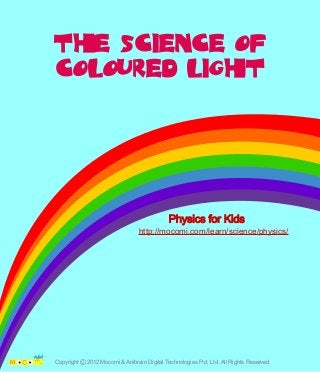Weitere ähnliche Inhalte Mehr von Mocomi Kids (20) Kürzlich hochgeladen (20) 1. The Science Of
Coloured Light
Physics for Kids
http://mocomi.com/learn/science/physics/
Copyright © 2012 Mocomi & Anibrain Digital Technologies Pvt. Ltd. All Rights Reserved.
2. Coloured Light
THE COLOUR OF LIGHT
Have you ever found yourself standing in front of a
beautiful picture, with all its beautiful colours, areas of
light and shadow, and wonder to yourself- 'How do I
see that?' Many of us take the act of seeing for
granted, but if you stop to examine the ability to see
colour you will surely be fascinated.
Light is a form of energy that is present everywhere in
our world. The reason we see colours and shapes is
second nature to us is because of the presence of
light. It is a wonderful phenomenon because it is at the
same time obvious and mysterious. There are many
questions about the nature of light that scientists have
dedicated their entire careers to researching its chemical, physical, biological and mathematical properties.
Copyright © 2012 Mocomi & Anibrain Digital Technologies Pvt. Ltd. All Rights Reserved.
3. Coloured Light
WAVES
The first thing you must understand before we move on
to the relation between light and colour is waves. A
wave is a disturbance in space where this motion
transfers energy from one point to the next. A wave has
a high point (peak) and a low point (trough). The distance between the peak and the trough is known as the
wavelength. The amoung of energy present in the wave
determines how long the wave is. A long wave has a low
frequency and low energy whereas a short wave has a
high frequency and a high amount of energy.
A
V
A
Properties of waves:
Wave lenght distance from crest to crest.
T Period - Time between passage of successive crests.
V Frequency - Number of crest passages per unit time.
A Amplitude - Distance from level of crest to level of trough.
Copyright © 2012 Mocomi & Anibrain Digital Technologies Pvt. Ltd. All Rights Reserved.
4. Coloured Light
RAINBOW - THE VISIBLE SPECTRUM
Light from the sun is essentially a form of energy
known as electromagnetic radiation. The phenomenon
we call light is the portion of electromagnetic radiation
that is visible to the human eye and is called the visible
spectrum. The different colours of light on the visible
spectrum is defined by their respective wavelengths.
When you look at a rainbow, you will always see the
colour red at the top and violet at the bottom. That is
because red has the highest wavelength and violet has
the least. The colours of the rainbow in increasing
order of wavelength are Violet, Indigo, Blue, Green,
Yellow, Orange, Red.
Copyright © 2012 Mocomi & Anibrain Digital Technologies Pvt. Ltd. All Rights Reserved.
5. Coloured Light
Waves such as infra-red, microwaves, and radio waves
have a higher frequency that red light. Ultra Violet,
X-ray, and gamma rays have a lower frequency than
violet. These cannot be percieved by the human eye
and therefore fall on the invisible spectrum.
Together the visible and invisible spectra of light make
up the electromagnetic spectrum.
Copyright © 2012 Mocomi & Anibrain Digital Technologies Pvt. Ltd. All Rights Reserved.
6. Coloured Light
COLOUR FROM LIGHT
Colour would not exist without light. When light hits an
object it is either transmitted, reflected, or absorbed.
When you say a leaf is green, you are actually saying
that the leaf reflects green wavelengths of light and absorbs all the others on the visible spectrum. The swan
in the picture is white because it reflects all wavelengths of light equally. His beak is yellow because it
Reflected
Copyright © 2012 Mocomi & Anibrain Digital Technologies Pvt. Ltd. All Rights Reserved.
7. Coloured Light
On the other hand a black stone is black because it absorbs all wavelengths of light. Therefore black is the
absence of light, just like a shadow.
Absorbed
Copyright © 2012 Mocomi & Anibrain Digital Technologies Pvt. Ltd. All Rights Reserved.
8. Coloured Light
Transmitted
Transmission is when an objects allows light to pass
through it. The escaped light will be the colour of the
material it passes through.
Try this yourself
Take a glass of water and add some red food colour
into it. If you put the glass in the sunlight, you will see a
ray of red light on the other side. This is because the
red food colour only allows red light to pass through it.
You can do this with any colour, not just red.
Glass with Water
After Adding Food colour
Copyright © 2012 Mocomi & Anibrain Digital Technologies Pvt. Ltd. All Rights Reserved.
9. Coloured Light
HOW WE PERCIEVE COLOUR
So we know that a leaf is green because it reflects only
green light. We can see this because we have colour
and light sensitive receptors in our eyes. These are
called rods (receptive to light) and cones (receptive to
colour).
For more such fun physics articles
and videos, visit:
http://mocomi.com/learn/science/physics/
Being able to see colour is a sensation just like the
sense of smell or taste. And just like things taste different to different people, no two people see colour in the
same way because the rods and cones in their eyes
vary.
Image references:
Swan - source: www.publicdomainpictures.net . This image is public domain. You may use this picture for
any purpose, including commercial.
Stone/Shell image - source: www.publicdomainpictures.net . This image is public domain. You may use this
picture for any purpose, including commercial.
Visible spectrum - source: www.wikipedia.org. This file is licensed under the creative commons attribution
Share Alike.
Glass/Sun/Leaf/eye/flower/boy/bird - source: www.openclipart.org. This image is public domain. You may
use this picture for any purpose, including commercial.
Copyright © 2012 Mocomi & Anibrain Digital Technologies Pvt. Ltd. All Rights Reserved.

